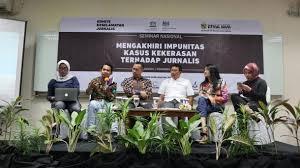
https://www.kompas.id/artikel/en-di-balik-meningkatnya-indeks-keselamata...
https://www.tifafoundation.id/en/
https://www.thejakartapost.com/indonesia/2025/02/24/media-violence-still...
TIFA Foundation, as part of the Safe Journalism Consortium, launched the 2024 Journalist Safety Index in Jakarta on Thursday (20/2/2025). The index reached 60.5 points or fell into the “Somewhat Protected” category. The index increased by 0.7 points compared to 2023.
However, the increase in the index does not guarantee improved press protection in the country. Violence against journalists continues to recur. Digital attacks targeting media websites are increasingly brutal. Meanwhile, censorship comes from inside and outside the newsroom.
The index uses a survey method of 760 journalists and secondary data analysis from the Alliance of Independent Journalists (AJI). This index aims to provide a comprehensive picture of the safety conditions of journalists in Indonesia.
Tifa Foundation Supervisory Board, Natalia Soebagjo, said that 66 percent of journalists admitted to being more careful in producing news. This is due to the threat of criminalization, censorship, and pressure from various parties.
"The forms of violence that are expected to increase in the next five years are coverage bans at 56 percent and news bans at 51 percent. The main actors considered threatening are community organizations at 23 percent and buzzers at 17 percent," he said.
:quality(80):watermark(https://cdn-content.kompas.id/umum/kompas_main_logo.png,-16p,-13p,0)/https://cdn-dam.kompas.id/photo/ori/2023/03/09/3bb3ddc6-729b-4471-a7dc-ed4d4accdfc0.jpg)
The 2024 Journalist Safety Index Report measures the level of journalist protection in Indonesia through three main pillars, namely individual journalists, media, and the role of the state and regulations. This report is the result of collaboration between the TIFA Foundation and Populix in the Safe Journalism program.
Natalia said, although the index increased, the study also showed major challenges in ensuring safer press freedom. Therefore, strategic steps are needed from various parties to support a better press life.
The government must revise regulations that limit press freedom and strengthen legal protection mechanisms for journalists. Meanwhile, media companies must increase their commitment to journalist safety through clear standard operating procedures (SOPs), safety training, and legal support.
"Meanwhile, journalist organizations and CSOs (civil society organizations) must also strengthen advocacy, legal assistance, and education for journalists in dealing with threats," he explained.
:quality(80)/https://cdn-dam.kompas.id/photo/ori/2023/01/23/deb6ed92-ab59-40b4-b5b0-9c75b46dd8bb.jpg)
Populix Social Research Manager, Nazmi Haddyat, explained that the findings of the 2024 Journalist Safety Index Report recorded that 167 journalists experienced violence in 321 incidents.
The most common forms of violence are bans on coverage at 56 percent and bans on reporting (51 percent). The main actors in cases of violence against journalists are community organizations (23 percent), buzzers (17 percent), and the police (13 percent).
As many as 39 percent of journalists admitted to having experienced censorship, either from editors or media owners. More than half of respondents also admitted to self-censoring to avoid conflict and controversy.
"From the state and regulatory perspective, the ITE Law (Electronic Information and Transactions Law) and the Criminal Code (KUHP) are still considered the main threats to press freedom," said Nazmi.
Through these findings, it is hoped that they can serve as a reference for the government, media organizations, and civil society in creating a safer working environment for journalists in Indonesia.
Bankrupting the media
Chairman of the Indonesian Cyber Media Association (AMSI) Wahyu Dhyatmika said that violence against the press was not only experienced by journalists, but also media companies. Digital attacks on media sites have become more massive in the last five years.
The most common forms of violence are bans on coverage at 56 percent and bans on reporting (51 percent). The main actors in cases of violence against journalists are community organizations (23 percent), buzzers (17 percent), and the police (13 percent).
"The targets of digital attacks are not only journalists, but also media websites. Because, media websites are the outlets of the key distribution of information that is being obstructed. So, when media websites are attacked and disabled so that they cannot be accessed, then that is a form of obstructing press freedom," he said.
According to Wahyu, the pattern of digital attacks is starting to be read. When the media produces news that attacks or criticizes a certain party, the media website will be attacked. The form of attack that often occurs is a distributed denial of service (DDos) attack or distributed denial of service.
The attack not only prevented people from accessing news. Media companies also suffered financial losses to deal with the attack. Server operating costs tripled.









